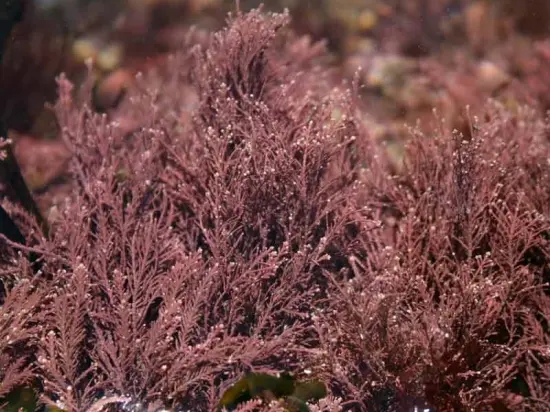
Corallina spp.
weeks

Typical applications: Corallina spp.
Typical applications
Soil Amendments: Ground coralline algae can be used as a soil conditioner due to their high calcium carbonate content.
Aquaculture: In aquariums and aquaculture, Corallina spp. are valued for their aesthetic appeal and their ability to promote coral health by providing calcium for calcifying organisms.
Biomedical Research: Their bioactive compounds are being studied for potential antibacterial and antifungal properties.

ALGANEX certificate system
Product information: Corallina spp.
Corallina spp. refers to a genus of red algae within the family Corallinaceae. These algae are known as coralline algae due to their hard, calcified structures. Corallina species play a crucial role in marine ecosystems, particularly in coral reefs and rocky coastal environments.
Characteristics
Appearance: Corallina spp. are characterized by their rigid, segmented, and often branching thallus (body) structure. The calcified segments give them a pinkish to reddish color and a tough, coral-like texture.
Calcification: They deposit calcium carbonate in their cell walls, making them hard and resistant to grazing by herbivores. This also helps them contribute to reef building and stabilization.
Habitat: Commonly found in intertidal and subtidal zones, often growing on rocks, shells, or other hard substrates in coastal areas.
Ecological Importance
Reef Building: Corallina spp. contribute to the formation and maintenance of coral reefs by acting as a binding agent, holding reef structures together with their calcium carbonate deposits.
Ecosystem Stability: They provide a habitat for various marine organisms, such as small invertebrates and fish, and play a role in coastal protection by reducing wave energy.
Indicator Species: Due to their sensitivity to changes in ocean acidity (pH levels), coralline algae serve as indicators of ocean health and are used in studies on ocean acidification and climate change.
What are the medicinal properties of Corallina spp. and how are they utilized?
Corallina spp. contain bioactive compounds that have shown antibacterial, antifungal, and antioxidant properties. These properties are being researched for potential applications in wound healing, infection control, and skincare products. Studies are exploring their use in preventing microbial growth and as natural preservatives.
How is Corallina spp. used in agricultural soil conditioning and nutrient supplementation?
Ground coralline algae are used as a soil conditioner and lime substitute. Its high calcium and magnesium content helps balance soil pH and provide essential minerals for plant growth. This can improve soil structure, enhance nutrient availability, and promote root development.
What bioactive compounds are present in Corallina spp. and their potential benefits?
Corallina spp. are rich in calcium carbonate, magnesium, and trace elements. They also contain polysaccharides and polyphenols that offer antioxidant benefits. These bioactive compounds are studied for their potential roles in improving bone health, boosting immunity, and reducing oxidative stress.
Can Corallina spp. extracts be used in skincare or cosmetics, and what are their effects?
Yes, extracts of Corallina spp. are used in skincare due to their mineral content and hydrating properties. They help improve skin texture, reduce inflammation, and support collagen production. The algae’s antioxidant and antimicrobial properties also help protect and soothe the skin.
How does Corallina spp. contribute to calcium and magnesium enrichment in soil and water?
Due to its calcified structure, Corallina spp. releases calcium and magnesium when it breaks down in soil or water. These minerals are crucial for plant growth and aquatic health, enhancing the nutrient profile of both marine and terrestrial environments.
What role do Corallina spp. play in aquaculture and maintaining marine aquarium environments?
In aquaculture and marine aquariums, Corallina spp. helps maintain calcium levels and provide a natural habitat for various marine organisms. Their calcified structures promote the growth of corals, crustaceans, and mollusks, which rely on calcium for their exoskeletons and shells.
How are Corallina spp. utilized in biotechnological or pharmaceutical research?
Corallina spp. is studied for its bioactive compounds, which exhibit antimicrobial, antioxidant, and mineralizing properties. Researchers are exploring these compounds for use in pharmaceuticals, such as antimicrobial agents, and in biotechnological applications, including biomaterials for bone regeneration.
What makes Corallina spp. effective as a natural fertilizer or soil amendment?
Corallina spp. is effective as a natural fertilizer due to its high calcium carbonate content, which helps neutralize acidic soils and improve soil structure. It also provides essential nutrients like magnesium and trace elements, enhancing soil fertility and promoting healthy plant growth.
Are there any antimicrobial or antifungal properties in Corallina spp. that can be harnessed? Yes, Corallina spp. contains compounds that have shown antimicrobial and antifungal activity. Studies indicate that its extracts can inhibit the growth of certain bacteria and fungi, making it a potential natural antimicrobial agent for use in pharmaceuticals and food preservation.
How does Corallina spp. improve water quality and marine habitat health in aquariums?
Corallina spp. contributes to water quality by providing a stable source of calcium and magnesium, essential for maintaining the pH balance and supporting the growth of marine organisms. Its structure offers a habitat for beneficial bacteria and small marine species, promoting overall ecosystem stability.
Sources
- Hamad GM, Samy H, Mehany T, Korma SA, Eskander M, Tawfik RG, El-Rokh GEA, Mansour AM, Saleh SM, El Sharkawy A, Abdelfttah HEA, Khalifa E. Utilization of Algae Extracts as Natural Antibacterial and Antioxidants for Controlling Foodborne Bacteria in Meat Products. Foods. 2023 Sep 1;12(17):3281. doi: 10.3390/foods12173281. PMID: 37685214; PMCID: PMC10486444. (https://pubmed.ncbi.nlm.nih.gov/37685214/)
- Nakajima Y, Kitpreechavanich V, Suzuki K, Kudo T. Microbispora corallina sp. nov., a new species of the genus Microbispora isolated from Thai soil. Int J Syst Bacteriol. 1999 Oct;49 Pt 4:1761-7. doi: 10.1099/00207713-49-4-1761. PMID: 10555358. (https://pubmed.ncbi.nlm.nih.gov/10555358/)
Reply within twelve hours